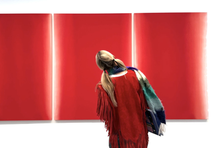Colouring the Past: Homer, Soane & Klein
- The Courtauldian
- Mar 28, 2019
- 3 min read

Yves Klein, Blue Venus works on display at Blenheim Palace, 2018 (Photo: Vogue)
Colour is a concerningly abstract and amorphous concept which we have to engage with on the daily, and much of the interest in the semi-myth that the ancient Greeks had no word for the colour ‘blue’ comes from a fundamental mistrust in the idea that our experience of colour is not a universal human experience. ‘Wine-dark’ sea is the traditional translated epithet given to Homer in place of blue. In fact, Homer used two adjectives to describe more intricate facets of the colour blue: kuaneos, a dark shade of blue leaning into black; and glaukos, a ‘blue-grey’, used in Athena’s epithet glaukopis – ‘grey-gleaming eyes’. An 1858 study (William Ewart Gladstone, Studies on Homer and the Homeric Age) concluded that the Greeks suffered from ‘defective’ vision in their inability to see certain colours. More recently, ancient colour perception has been a catalyst through which to debate cross-cultural universals and cultural relativism. Closer to Courtauldian interests, the field of colour relativism throws our understanding and studies of ancient art into wild uncertainty.
How could ancient people, who made such an effort in coloring their clothing, have surrounded themselves with pale and colorless architecture and pieces of art? (Johann Winckelmann, The History of Art in Antiquity)
The false image of the sober, white marble statues of ancient Greece is a well-discussed topic nowadays. Various accusations of imperialism and colourism arise to follow the heart-breaking image of renaissance archaeologists, upon digging up an ancient statue still bearing residual flakes of polychromy, quickly brushing it off as dirt – cleaning each figure vigorously before presentation to the public to reveal the preferable plain white marble. It’s funny to imagine how the original audiences would have reacted to the colourless galleries of ancient Greek art across the world. Euripides’s tragic play Helen, 412BC, confirms that not only were these statues lavishly painted, but their plain white bases were seen as unsightly – Helen states, “If only I could be wiped out like a statue, assuming an uglier form rather than a beautiful one.”

Figure 1. Vinzenz Brinkmann, Polychromy reconstruction of warrior's head from the east pediment of the Temple of Aphaia, 510-470 BC (Photo: Art-Sheep.com)
The custom of restoring models of ancient pots and sculptures to their former gaudy glory has only recently come into vogue, with the polychromy research and reconstructed images of Vinzenz Brinkmann becoming iconic (Fig. 1). However, the violation of classical purity with bright colour has been the subject of experimentation for centuries. We may feign steadfast traditionalism in loving the plain and uncomplicated surfaces of our ancient sculpture, but throughout history we have consistently delighted in bringing colour back to them. Rococo’s soft pink cloth, lucid sunsets, and thick green Eden-esque settings do this well, fully indulging in the limits of the imagined arcadian classical past. John Soane’s neoclassicism is nowhere more evident than both in his house at Lincoln’s Inn Fields, and his country villa at Pitzhanger, Ealing – and yet his spin on neoclassical architecture is far from sober and white. Sir John Soane’s Museum maintains true to the original interior design with those bright red and yellow walls, green alcoves, and of course, the butter-yellow glass that fills the otherwise labyrinthine building with faux-Mediterranean sunshine. Pitzhanger manor, too, takes elaborate neoclassical mouldings and paints them a doughy baby blue. I was especially interested to see the paint samples on the walls on my visit there recently, showing the legacy of bright colour that extended throughout the history of the house (Fig. 2).

Figure 2. Pitzhanger Manor, Eating room paint scraping, 2018 (Photo: Pitzhanger Manor House and Gardens)
Talking about colour theory is hard without consideration of Yves Klein. His ‘Blue Venus’ (Fig. 3) is covered in his self-made blue pigment ‘International Klein Blue’, which at first seems to distract from the familiar forms of the Venus’s body – but the texture and materiality of his paint, combined with the historical objectality of that limbless, headless Venus in the canon of art history, defines the work as a bold institutional interrogation of the conventions of female ancient form. A 2018 showing of his work recognised this conflicting dialogue and its irony and displayed Klein’s works within the grand, opulent neoclassical context of Blenheim Palace in Oxfordshire. The research surrounding the ancient absence of words for the colour ‘blue’ was conducted way before Klein’s time – I wonder if he knew of this small ironic intricacy while working on Blue Venus.

Figure 3. Yves Klein, Blue Venus, 1961, Painted plaster (Photo: The Metropolitan Museum of Art)












Comments